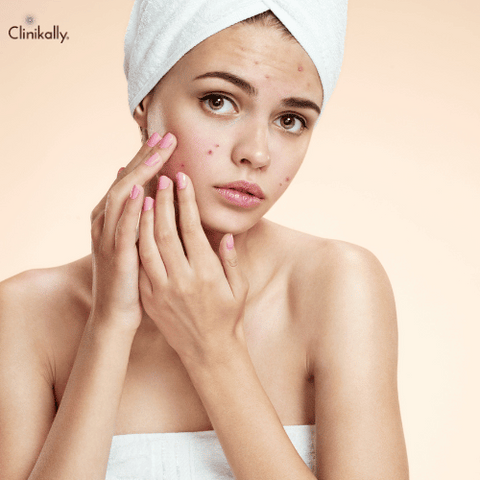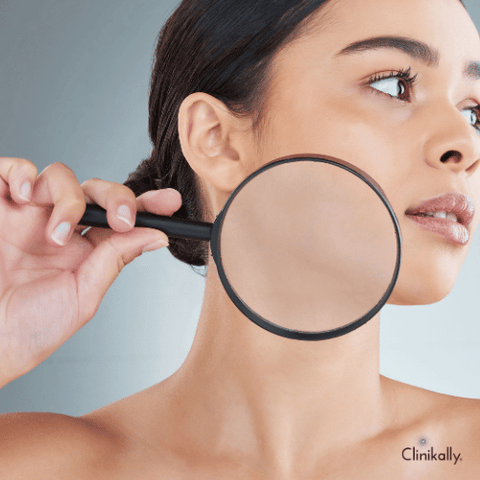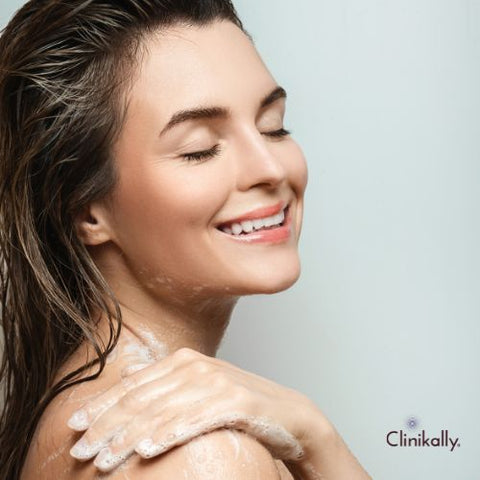Melasma is a skin disorder in which your skin's melanocytes (color-producing cells) produce extra pigment for unknown reasons. It's also known as chloasma, or the "mask of pregnancy" during pregnancy. It is difficult to prevent because it results from hormonal changes and increased sun exposure. However, the following advice can help you safeguard your skin and avoid melasma while pregnant:
-
Wear sunscreen: Even on cloudy days, you should always put on broad-spectrum sunscreen with an SPF of 30 or higher. If you plan to spend a lot of time outside, apply it every two hours.
-
Use a hat or umbrella: Wear a hat with a wide brim or carry an umbrella to shade your face from direct sunlight.
-
Avoid sun exposure during peak hours: Try to avoid going outside during peak hours of sun exposure, which are usually from 10 a.m. to 4 p.m.
-
Wear protective clothing: To shield your skin from damaging UV rays, wear long sleeve shirts and breathable pants.
-
Use gentle skin care products: Steer clear of abrasive skincare items and opt instead for mild, fragrance-free alternatives that won't irritate your skin.
-
Keep hydrated: Water is essential for maintaining healthy, hydrated skin.
-
Use topical remedies: Ask your dermatologist about topical remedies like hydroquinone, kojic acid, or azelaic acid that can help lessen the appearance of melasma.
Keep in mind that the best defence against melasma during pregnancy is prevention. You can reduce your risk of developing melasma or making it worse by taking precautions to protect your skin from the sun and using gentle skin care products.
Understanding Melasma and Pigmentation During Pregnancy

Melasma is a common skin condition marked by brown or greyish-brown patches on the face, particularly the cheeks, forehead, nose, and upper lip. It is also referred to as "chloasma" or the "pregnancy mask" because it frequently affects pregnant women as a result of hormonal changes in their bodies. Melasma is caused by melanocytes, the skin's pigment-producing cells, which produce an excessive amount of pigment. Hormonal changes are known to play a role, though the precise cause of this overproduction is not fully understood. Melasma can also occur in women who use birth control pills or receive hormone replacement therapy.
Melasma associated with pregnancy typically appears in the second or third trimester and may get worse with exposure to sunlight. Melasma is more likely to occur in women with darker skin tones than in those with lighter skin tones. Along with melasma, pregnant women may also develop other forms of hyperpigmentation, such as linea nigra, darkening of the areolas, and genital discoloration. Hormonal changes during pregnancy are another factor contributing to these changes.
While melasma and other types of hyperpigmentation are not harmful during pregnancy, they can be upsetting for some women. Thankfully, most melasma and hyperpigmentation cases go away after delivery, though it could take months or even years for the skin to look normal again. Topical creams with ingredients like hydroquinone, tretinoin, and azelaic acid may be used as a treatment for melasma and hyperpigmentation during pregnancy. However, before using any skin care products or treatments while pregnant, it's important to speak with your healthcare provider, as some may not be appropriate. In order to help stop further pigmentation during pregnancy, it's also crucial to use sun protection, such as wearing a hat and applying sunscreen.
The Role of Hormonal Changes and UV Exposure
The development of melasma is primarily influenced by hormonal changes and UV exposure.
Hyperpigmentation can be caused by hormonal changes, especially the increased levels of progesterone and estrogen during pregnancy. These hormones can also stimulate melanin production in the skin. This hormonal stimulation may also result in the development of new blood vessels in the skin, which may aid in the melasma development process.
Melasma can also develop as a result of UV exposure, especially to ultraviolet A (UVA) and ultraviolet B (UVB) radiation. Existing melasma patches may become darker and more noticeable when exposed to sunlight because UV radiation stimulates the skin's production of melanin. Particularly UVA radiation can damage pigment-producing cells by penetrating the skin deeply.
UV exposure can promote the production of melanin while also harming the skin through oxidative processes that result in inflammation and the destruction of collagen and elastin. This may accelerate the appearance of wrinkles, fine lines, and other aging symptoms. Protecting your skin from UV rays is crucial for preventing melasma and other types of hyperpigmentation. This can be accomplished by daily application of broad-spectrum sunscreen with an SPF of at least 30 and by wearing protective clothing like hats and long-sleeved shirts. It's also important to seek shade whenever you can and to avoid being in the sun between the hours of 10 a.m. and 4 p.m.
Types of Pigmentation: Melasma, Chloasma, and Linea Nigra
Melasma, chloasma, and linea nigra are just a few of the pigmentation conditions that can manifest themselves during pregnancy.
-
Melasma: Melasma is a common type of pigmentation that causes dark, discoloured patches on the face, particularly on the cheeks, forehead, nose, and upper lip. The "mask of pregnancy" or chloasma is another name for it because it frequently affects pregnant women as a result of their bodies' hormonal changes.
-
Chloasma: The term "chloasma" is used to refer to melasma as well as other types of hyperpigmentation on the skin. Chloasma can also appear on the arms or legs, among other parts of the body.
-
Linea Nigra: During pregnancy, typically in the second or third trimester, a dark line called a linea nigra develops on the belly. The line from the belly button to the pubic bone runs vertically down the middle of the abdomen. Melanin production is increased as a result of hormonal changes that occur during pregnancy, which results in a linea nigra.
While these types of pigmentation are not harmful, they can be distressing for some women. The majority of melasma, chloasma, and linea nigra cases go away after delivery, though it could take months or even years for the skin to look normal again. If your skin changes at all while you're pregnant, it's crucial to get an online dermatologist consultation. Your healthcare provider can give you advice on the best course of action, including whether any topical medications are safe to use while pregnant.
How to Prevent Melasma During Pregnancy

Preventing melasma during pregnancy can be challenging, but there are several steps that women can take to reduce their risk of developing this condition:
-
A broad-spectrum sunscreen with an SPF of at least 30 should be worn every day to protect your skin from the sun's harmful rays since UV radiation is known to be a melasma trigger. Make sure to reapply sunscreen every two hours, as well as after swimming or perspiring.
-
When possible, seek out shade and wear a wide-brimmed hat to further shield your face from UV rays. This is especially important during peak sun hours.
-
It's important to avoid tanning beds and prolonged sun exposure because both can exacerbate melasma.
-
Use skincare items that are gentle and free of harsh chemicals, fragrances, and dyes.
-
Consult your doctor about your risk of developing melasma during pregnancy and how to prevent it if you have a history of the condition or other skin problems. You can also consult dermatologists on a trusted online skincare platform.
-
Talk to your doctor about any hormonal changes you're experiencing and ways to manage them since hormonal changes during pregnancy can contribute to the development of melasma.
Remember that prevention is key when it comes to melasma during pregnancy. By taking steps to protect your skin from UV radiation and being mindful of your skincare routine, you can reduce your risk of developing this condition.
UV Protection: Sunscreen and Clothing
Pregnancy melasma can be prevented, in part, by wearing sunscreen. Here are some strategies for shielding your skin from UV rays:
-
Sunscreen: It's essential to use a broad-spectrum sunscreen with an SPF of at least 30 every day to shield your skin from UV rays. Your face, neck, hands, ears, and any other exposed skin should all be covered with sunscreen. Reapply after swimming or perspiring every two hours.
-
Clothing: Covering up against UV radiation can also be done by wearing protective clothing. Choose tightly woven fabrics and wear long-sleeved shirts and pants. In comparison to light colors, dark colors typically offer more protection. You can also cover your face, neck, and ears by donning a hat with a wide brim.
-
Seek Shade: You can lessen your exposure to UV radiation by finding shade, especially during the sun's most intense hours.
-
Avoid Tanning: Since tanning can exacerbate melasma, it's important to stay away from tanning beds and prolonged sun exposure.
-
Consider Using a Physical Sunscreen: Physical sunscreens, which offer a physical shield between your skin and the sun's rays, should be used. Examples include those containing zinc oxide or titanium dioxide.
Keep in mind that sun protection is essential even on cloudy days because UV radiation can still pass through them. You can lessen your risk of developing melasma while pregnant by taking these precautions to protect your skin from UV radiation.
Antioxidants and Vitamins for Skin Health
Vitamins and antioxidants are necessary to maintain healthy skin. They can improve skin texture and tone, stimulate the production of collagen, and shield the skin from UV rays and other environmental stresses. The following are some of the essential vitamins and antioxidants for healthy skin:
-
Vitamin C: Vitamin C is an effective antioxidant that can help shield the body from UV rays and other environmental stressors. It also plays a key role in collagen production, which can improve skin texture and tone.
-
Vitamin E: Vitamin E is another antioxidant that can help to protect against UV radiation and other environmental stressors. It also helps to moisturize and soothe the skin.
-
Vitamin A: Vitamin A, also called retinol, is a strong antioxidant that helps to lessen the visibility of fine lines and wrinkles. It can also improve skin texture and tone.
-
Vitamin B3: Also referred to as niacinamide, vitamin B3 is an antioxidant that can help to lessen inflammation and enhance the texture and tone of the skin. It also helps to strengthen the skin's barrier, which can improve moisture retention.
-
Vitamin D: Vitamin D is crucial for healthy skin because it controls cell division and repair. It also plays a key role in reducing inflammation and promoting wound healing.
-
Antioxidant-rich foods: Your skin's health can also be enhanced by including foods high in antioxidants in your diet. These consist of foods like berries, citrus fruits, leafy greens, and sweet potatoes as well as other fruits and vegetables.
Remember that eating a balanced diet full of whole foods is the best way to guarantee that you are getting all the vitamins and antioxidants you require for healthy skin. However, you might also think about taking a daily multivitamin or supplement if you are worried about your nutrient intake. Before beginning any new supplements, it's crucial to consult your healthcare provider.
Using Zinc Oxide: Physical vs. Chemical Sunscreens
Zinc oxide is a common component of sunscreens and can offer efficient UV protection. Zinc oxide is a component of both chemical and physical sunscreens.
Physical sunscreens contain zinc oxide, which forms a physical barrier on top of the skin that reflects and scatters UV rays. This kind of sunscreen is additionally referred to as mineral sunscreen. Physical sunscreens are more likely to leave a white cast on the skin and have a tendency to be thicker, but they are less likely to irritate the skin or trigger allergic reactions. On the other hand, chemical sunscreens have ingredients that absorb UV radiation and turn it into heat that is then expelled from the skin. Chemical sunscreens are frequently thinner and simpler to apply, but they might be more likely to irritate the skin or trigger allergic reactions.
A physical sunscreen with zinc oxide may be a better choice if you have sensitive skin or are prone to skin allergies. Not all physical sunscreens, however, are created equal, and some may contain additional ingredients that can irritate the skin or trigger allergic reactions. It's crucial to carefully read the labels and select a sunscreen that is made with sensitive skin in mind. Regardless of the type of sunscreen you pick, it's crucial to use a lot of it and reapply it every two hours, or more frequently if you are swimming or perspiring. To reduce your risk of skin damage and melasma, keep in mind that wearing sunscreen is only one part of a comprehensive sun protection strategy. You should also look for shade, wear protective clothing, and avoid tanning.
How to Treat Pigmentation During and After Pregnancy

Treatment of melasma, chloasma, and linea nigra can be difficult during and after pregnancy, but there are a number of approaches that may help. Here are some remedies that might work:
-
Topical creams: Topical creams with prescription-strength ingredients such as hydroquinone, tretinoin, and azelaic acid can aid in minimizing the appearance of pigmentation. These creams work by inhibiting melanin production, promoting skin cell turnover, and reducing inflammation.
-
Chemical peels: Chemical peels involve the application of a chemical solution to the skin, which exfoliates the outer layer of the skin and can help to reduce pigmentation. Chemical peels can be performed in a dermatologist's office and may require multiple treatments.
-
Laser therapy: Laser therapy involves the use of intense pulsed light or lasers to target pigmented areas of the skin. This can help to break up melanin and improve the appearance of pigmentation. The cost and number of treatments associated with laser therapy can add up.
-
Microneedling: Using a device that punctures the skin minutely, micro-needling can increase collagen production and improve the appearance of pigmentation. Microneedling can be carried out in a dermatologist's office and may call for multiple sessions.
Before beginning any new treatments, it's crucial to remember that some of these may not be safe for use during pregnancy. Additionally, it's essential to continue using sun protection and refrain from tanning during and after pregnancy in order to prevent the development or aggravation of pigmentation. These treatments, along with other preventative measures, may help to lessen the appearance of pigmentation and encourage healthy, radiant skin.
Topical Treatments for Pigmentation: Skin Brightening Agents
Numerous topical remedies can lighten the skin and lessen the appearance of pigmentation. The following are some typical ingredients in topical treatments that lighten the skin:
-
Hydroquinone: Hydroquinone is a topical skin-lightening agent that reduces the production of melanin. It is one of the best skin-lightening products on the market and is frequently used to treat melasma and other types of hyperpigmentation. However, prolonged use of hydroquinone may be harmful and result in allergic reactions or skin rashes.
-
Vitamin C: Vitamin C is an effective antioxidant that can lighten skin tone and lessen the appearance of pigmentation. It functions by promoting collagen production while inhibiting melanin production. There are several different forms of topical vitamin C, including ascorbic acid, magnesium ascorbyl phosphate, and sodium ascorbyl phosphate.
-
Kojic acid: Kojic acid, which is derived from mushrooms, is a natural skin-lightening agent. It can be useful in minimizing the appearance of pigmentation because it inhibits the production of melanin. It might be less effective than other skin-lightening products and can irritate the skin.
-
Azelaic acid: Azelaic acid is a topical medication that is often used to treat acne, but it can also help to reduce the appearance of pigmentation. It works by inhibiting melanin production and reducing inflammation. Azelaic acid is generally well-tolerated and can be used long-term.
-
Alpha arbutin: Alpha arbutin is a natural skin-lightening agent that is derived from the bearberry plant. It works by inhibiting melanin production and can be effective in reducing the appearance of pigmentation. It's generally well-tolerated and can be used long-term.
Sun protection should always be used when using topical pigmentation treatments, and all directions should be followed carefully.
When to See a Dermatologist: Laser Treatments and Chemical Peels
It may be time to visit a dermatologist for more sophisticated procedures like laser therapy or chemical peels if you have tried topical treatments and sun protection measures but have not noticed a significant improvement in your pigmentation. These procedures carry potential risks and complications if not done correctly, so they should only be performed by a dermatologist who holds a license. Laser therapy and chemical peels can be effective in reducing the appearance of pigmentation, but they can also irritate the skin. If not done properly, they could sometimes even worsen pigmentation. The best course of action for your unique skin type and pigmentation problems can be decided after a dermatologist examines your skin.
You should consult a healthcare professional before undergoing any advanced skin treatments if you are pregnant or have any underlying skin conditions. Some treatments might not be suitable for use during pregnancy or might interact with certain drugs or health issues. In general, if you have concerns about pigmentation or other skin problems, it is best to speak with a dermatologist. To get the best results for your skin, a dermatologist can assist you in creating a personalized treatment plan.
Tips for Maintaining Skin Health After Pregnancy
Maintaining your skin's health and avoiding additional pigmentation after giving birth requires continued care. Following delivery, keep your skin healthy with this advice:
-
Keep applying sunscreen: Sunscreen is crucial for preventing pigmentation and other skin damage. Even if you don't spend a lot of time outside, UV radiation can still damage your skin through windows. Continue to use broad-spectrum sunscreen with at least SPF 30 and wear protective clothing, such as hats and sunglasses.
-
Moisturize regularly: Moisturizing your skin helps to keep it hydrated and supple. Choose a moisturizer that is suitable for your skin type and contains ingredients such as hyaluronic acid, glycerin, or ceramides to help maintain skin barrier function.
-
Incorporate antioxidants into your skincare routine: Antioxidants can help to protect your skin from environmental damage and improve its overall health. Look for skincare products that contain vitamin C, vitamin E, or green tea extract to incorporate antioxidants into your skincare routine.
-
Use gentle skincare products: After pregnancy, your skin may be more sensitive and prone to irritation. Choose skincare products devoid of irritating ingredients and fragrances, and stay away from scrubs and exfoliants that can aggravate your skin even more.
-
Consider professional treatments: Consult a dermatologist about professional treatments like chemical peels or laser therapy if you continue to experience pigmentation or other skin issues following pregnancy. These procedures have the potential to reduce pigmentation's visual impact and enhance skin health in general.
Remember to be patient and consistent with your skincare routine, as it can take time to see improvements in your skin. Additionally, if you notice any odd changes in your skin or have worries about pigmentation, it's important to speak with a dermatologist or healthcare professional for additional assessment and treatment.
Get Spot-free Skin After Pregnancy!

Many pregnant women experience melasma and pigmentation, which are common skin problems. There are steps you can take to prevent and treat pigmentation, but hormonal changes and UV exposure can cause these conditions. Antioxidants, a healthy diet, and other preventative measures can help keep the skin healthy while pregnant. Topical medications like skin brightening agents can also help to lessen the appearance of pigmentation. If these methods don't work, a dermatologist with the necessary training should perform more complex procedures like chemical peels or laser therapy, which may be necessary.
After pregnancy, it's important to continue to take care of your skin to maintain its health and prevent further pigmentation. You can keep your skin healthy by including antioxidants, mild skin care products, and sun protection in your routine. If you have concerns about pigmentation or other skin conditions, it's important to speak with a dermatologist or healthcare provider. Professional treatments may also be required. Keep in mind that every person's skin is different, so what works for one person might not work for another. When it comes to your skincare regimen, be patient and consistent. If you have any questions about pigmentation or other skin problems, speak with your doctor or a dermatologist.









































